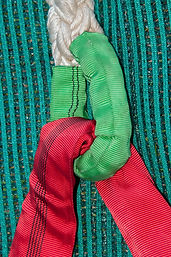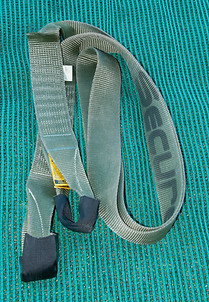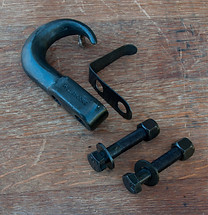
ifit4x4
by Piet van Heerde
iplan4x4
itour4x4

RECOVERY EQUIPMENT
ipull4x4
Getting stuck is part of the deal, if you don't get stuck every now and then you're doing it wrong. The secret however is to get unstuck as safely and elegantly as possible, without breaking anything. I look at the correct equipment and some procedures.

Recovery equipment is something you only need when you don't want to. Fact of the matter is that if you travel with your 4x4 vehicle, you are going to be stuck some time or another, no matter what. We look at the equipment needed to make this mishap as safe and easy as possible.
First of all, when you are stuck, stay calm, I know, it is a natural reaction to try to get out of trouble as fast as possible, STAY CALM.
The best advise I always give is to get out your camping chair and find shade, sit away from the problem and look at it, this is the best way to make the safest and most effective plan.
Only one person can be in charge, only he can give commands and orders.
First make sure that all the bystanders are a safe distance away from the action.
Make the plan, it must be safe, doable and have the least damage to the vehicles and environment.
Make use of what you have, everybody doesn't have all the correct equipment with them all the time, be innovative, make use of what you have and improvise, as long as you are making sure it is safe and nobody can get hurt.
And then before you start, agree on all the signals and commands you will be using.
THE EQUIPMENT

The most important principle about recovery equipment is to make sure to use of the correct rated equipment, this your key to safety. Make sure that you know what the rating of your recovery points is, the rating of the equipment and the rating of the recovery vehicle's points.
You also need to know the weight of your vehicle, loaded as is. Your rated equipment will have a MBS rating that must be two to three times bigger than your maximum vehicle mass. Even your shackles must have a rating, the MBS of a shackle is the WLL, printed on the shackle times 4,
and that must always be higher than the rating of your straps.
If you are using equipment that is not rated, you should just chuck it and get rated equipment.
SAFETY ALWAYS COMES FIRST
Have you seen dead people, people that got their jaws knocked off.
The chair

Make sure to pack your thinking chair at a convenient, easy to reach place. Test this chair beforehand to make sure it can carry your weight. Obviously this chair as shown in the picture,
bikini fishing chair, works the best. Once you are sure that you are truly stuck, get the chair out and walk away far enough from the incident to get a good view, from where you can take everything into consideration.
It might be necessary to walk around your vehicle several times to make proper assessment of the situation.
Now plan the most effective safest recovery possible with the available equipment.
The gloves

Gerrie 'Seer Handjies' Coetzee
You can use a pair of those thick and cheap welding gloves for doing the recovery work, but a tight fitting pair of pigskin gloves works better.
There are loads of different more synthetic gloves on the market
nowadays. Have a look at the hardware store.
These are not just for doing recoveries, you should also be wearing them for making camp, building a fire and all tasks where your hands can get pinched or blistered.
Recovery Blanket

Hang in there...
When doing a recovery using a winch or static rope, you must have a recovery bag or similar to dampen the slingshot in the event of a breakage.
You can buy a purpose made recovery bag or improvise and use any heavy soft item that you can drape over the cable.
Bow Shackles

The connectors
Buying the correct shackles is essential, they must be big and strong enough, as rated, and most important fit to your vehicles recovery points. A good tip is to know when
tightening the pin, is to tighten until it is tight and then half a turn back, this is important as to get it loose again it will not be stuck. The rated information must
be cast into the unit and normally multiplied by 4 and be higher than the rating of your straps, otherwise they break first and that can be catastrophic.
Bridle

Split the Forces
Whist doing a recovery, there are huge forces involved, the best thing to do to counter these forces is to have at least two recovery points on the front and two on the rear of your vehicle.
Use your bridle to split these forces by connecting your kinetic or static strap to the bridal by slipping the bridal
through the lasso of the strap. Then connect the bridle's two ends to the two recovery points respectively.
This makes the recovery so much safer.
A bridle could also be used as a static strap.
Make sure to buy a rated strap that is suitable for your vehicle.

Connect the bridle to the strap
Lanyard

Play it safe
The lanyard is basically just a safety measure that you connect to the bridle, or directly to the recovery strap, if you are not using a bridal. The other end, is then connected to another recovery point on your vehicle.
The reason for this is that in case there is a failure of your main recovery point or shackle, it would not catapult and cause serious damage.
It must have play and not influence any working part during the recovery.

Connect the lanyard to the bridle

Bridle and lanyard connected to vehicle
Tow strap or static strap

Old faithfull
The straight forward 5m long tow rope or strap is probably the piece of recovery equipment that you are going to use the more frequent.
90% of the time you old only
need a pul with a tow strap so that your vehicle could get traction again.
Always try to give a gentle pull before you try to do the very dangerous kinetic strap
recovery.
Never, but never give a tug or jerk, this is when you are going to break something or someone.
Recovery point

For a kinetic recovery, where you basically catapult the stricken vehicle out of mud or sand, a rated recovery hook is the best option. The one in the picture is rated 4535kg MVM and has a special plate to keep the strap in place.
On the chassis
This could be used without having to connect with a shackle as well, much safer.
The hook needs to be bolted directly to the chassis of your vehicle with high tensile steel bolts of at least 10mm.
You should never connect a kinetic strap to a non rated point, a bull bar or tow hook, not even to a hook that is welded on, even if you are the best welder south of the Sahara.
Kinetic rope

The kinetic rope, as in the picture is the more popular of the two types. You also get a kinetic strap but that needs a recovery time after each use and have limited usage.
The kinetic rope is a spliced rope that acts as a kinetic rope by the way it is spliced.The way it works is that you connect the rope to the back of the recovery vehicle
Giant elastic
and to the stricken vehicle, to your recovery points and equipment as discussed before. There must be some slack between the two vehicles.
The recovery vehicle then accelerate away and the rope is stretched out, up to a point where all the energy from the recovery vehicle is in the rope and that is then transferred,
the stricken vehicle will jump out of the sand or mud. Use as little force as is needed.
Unlike a static strap, it does not use the power of the vehicle but the momentum of the recovery vehicle.
Never attempt this unless you have had sufficient training to do so. All bystanders to be at least a rope's length away, only one person in charge
Basics of a kinetic recovery
Positioning: Park the recovery vehicle in front of the stricken vehicle, not more than 10 degrees off the line of intended recovery. Always with the rear of the vehicle towards the stricken vehicle, never do this in reverse as there are too high forces on the drive train and the recovery vehicle could easily damage the drive train.
Open up: If the stricken vehicle is lying on it's stomach, try and dig as much as possible to clear in front of the wheels.
Play it safe: If you have two recovery points, use a bridle to split the load and

Give slack: The kinetic rope needs to have a slack of about 3 meters in order to give the recovering vehicle space to pick up some speed to gain momentum. If you can not get close enough to the stricken vehicle, a second kinetic rope could be used by hooking their nooses through each other as in the picture. Never ever use a shackle to join the two, that is a sure recipe for disaster.
use a safety lanyard, even if it is an old piece of rope lying on the back of the bakkie. Also put some damping on the kinetic rope, improvise here as well, even if you use Ouma's old coat, just to be safe if anything breaks. Open the bonnet of the stricken vehicle if recovering forwards.
Rated: Only use rated equipment, the minimum breaking strength of the rope, must be at least twice the weight of your vehicle and not more than three times as then the elastic effect of the rope will not take place. And your shackle's WLL must be bigger than stricken vehicles MVM.

Pull up a chair: After everything is connected, pull up a chair, be calm and sit down and look everything over. Big mistakes are often made by being over eager.

Put a newspaper, magazine or some pieces of wood in between, otherwise you will never get them loose again.
Make space: After you overlooked everything make space, all onlookers must be more than a rope's length away, square to the vehicles, nobody to be in line with the recovery. And absolutely nobody between the vehicles.
Appoint a ref: Use a third person that can be seen by both drivers of both vehicles to give the sign that the recovery will start. Make sure both drivers knows what to do and what to expect. Using radios during such an event is very helpful, with the third person on a handheld radio. Both vehicles to select a gear in which they can accelerate fast but have enough torque as well, second low is always

a good choice.
The recovering vehicle must accelerate, but not as in drag racing, at the time of impact he should be doing between 12 and 18km/h, the stricken vehicle must also put a bit of foot to help with the recovery and after his slingshot acceleration be on par with his speed.
And again: Never in reverse for recovery vehicle, you can easily break something.

